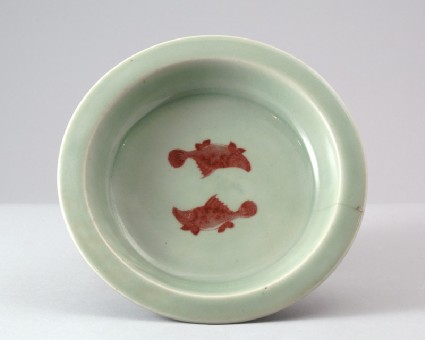The Barlow Collection
A select catalogue of the Barlow collection of Chinese Ceramics, Bronzes and Jades by the University of Sussex (published Sussex, 2006).

Publications online: 456 objects
Dish with two mandarin fish
- loan
-
Literature notes
This dish does not closely copy an ancient model, but its general shape and design appear to be inspired by the twin-fish dishes of Longquan celadon, where the fish are applied in relief (see Barlow Collection, [LI1301.198]). Underglaze painting was, however, not used for dishes of this type, which date from the Southern Song (1127–1279) or early Yuan (1279–1368) period. The piece is also much heavier, the shape more angular, the outside is decorated with stripes instead of lotus petals, and the ‘twin fish’, which generally are carp, have here become mandarin fish. The piece is made of white porcelain rather than grey stoneware.
The dish has a flat centre, curved sides with a flat everted rim, and a low tapering foot. The inside is painted in underglaze red with a pair of mandarin fish, the outside shows broad vertical carved stripes. The pale translucent green glaze covers a very white porcelain body, which shines through and is visible at the footring. The base shows firing cracks. -
Details
- Associated place
- Date
- 1911 - 1943
- Material and technique
- porcelain, thrown, with carved and copper-red decoration under a green glaze
- Dimensions
-
4.7 cm (height)
20.5 cm (diameter)
at foot 10.7 cm (diameter)
- Material index
- Technique index
- Object type index
- No. of items
- 1
- Credit line
- Lent by the Sir Alan Barlow Collection Trust.
- Accession no.
- LI1301.269
-
Further reading
University of Sussex, and Arts and Humanities Research Council, The Barlow Collection, supervised by Regina Krahl, Maurice Howard, and Aiden Leeves (Sussex: University of Sussex, 2006), no. C264
Glossary (2)
glaze, porcelain
-
glaze
Vitreous coating applied to the surface of a ceramic to make it impermeable or for decorative effect.
-
porcelain
Ceramic material composed of kaolin, quartz, and feldspar which is fired to a temperature of c.1350-1400⁰c. The resulting ceramic is vitreous, translucent, and white in colour.
Location
-
- currently in research collection
Objects are sometimes moved to a different location. Our object location data is usually updated on a monthly basis. Contact the Jameel Study Centre if you are planning to visit the museum to see a particular object on display, or would like to arrange an appointment to see an object in our reserve collections.
Publications online
-

The Barlow Collection
This dish does not closely copy an ancient model, but its general shape and design appear to be inspired by the twin-fish dishes of Longquan celadon, where the fish are applied in relief (see Barlow Collection, [LI1301.198]). Underglaze painting was, however, not used for dishes of this type, which date from the Southern Song (1127–1279) or early Yuan (1279–1368) period. The piece is also much heavier, the shape more angular, the outside is decorated with stripes instead of lotus petals, and the ‘twin fish’, which generally are carp, have here become mandarin fish. The piece is made of white porcelain rather than grey stoneware.
The dish has a flat centre, curved sides with a flat everted rim, and a low tapering foot. The inside is painted in underglaze red with a pair of mandarin fish, the outside shows broad vertical carved stripes. The pale translucent green glaze covers a very white porcelain body, which shines through and is visible at the footring. The base shows firing cracks.
Notice
Object information may not accurately reflect the actual contents of the original publication, since our online objects contain current information held in our collections database. Click on 'buy this publication' to purchase printed versions of our online publications, where available, or contact the Jameel Study Centre to arrange access to books on our collections that are now out of print.
© 2013 University of Oxford - Ashmolean Museum



